
Journey with Raven • Arches National Park

Wonders of Nature
Humans pride themselves on inventing the arch, the basis for all architecture. Frankly, I think mankind had better get used to a humble second: nature has been making arches for millions of years. And one of the best places to see her handiwork is just a few miles north of Moab, Utah: Arches National Park.
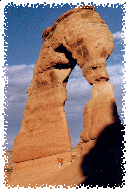 |
| Delicate Arch at Sunset |
We had been to the park way back in December, and like so many other places on the trip, one visit just wasn't enough. Last time we didn't allow enough time to get to Delicate Arch via trail and had to content ourselves with a distant glimpse from across a small valley. This time we conspired to catch it at Sunrise.
From almost a mile (the distance we saw it from last year,) and in all the photographs we had seen of it, it genuinely seemed delicate: a ring of stone looking more like a half-dissolved lifesaver than some magnificent product of nature.
But the word delicate took on a whole new meaning once we got there and we discovered just how massive it was. The opening alone is just short of fifty feet high, and not quite as wide. Geologically speaking, however, its days are numbered, and soon it will crumble away. Still, it is one of the most characteristic arches in the park.
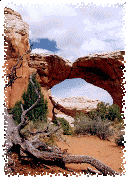 |
| Broken Arch |
Raven turned out to be his trickster self this day. In spite of the beautiful morning, and the opportunity to watch the sun rise over the arch, the weather was starting to move in. The slickrock trail on the way to the arch subjected us to occasional gusts, but on the final bend, when we round the last corner on a ledge only a few feet wide, fierce winds buffeted us, tugging at anything loose. (All the while, Raven frolicked in the air above our heads, thoroughly enjoying himself in the eddies and currents the stone provided.)
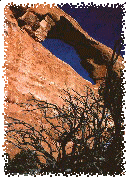 |
| Skyline Arch (photo from December 1996) |
The weather was moving in rapidly: to the west, the sky was already an unsettling gray blur. We headed down the trail and sought refuge in the rental car while the rain came down around us. We had pretty good luck waiting out the rain at Bryce so we thought we'd try our luck again. Fortunately, we did get a reprieve, but the sun never really came out with any intensity. The rest of the day would be just so-so photography weather. One of the better shots turned out at Broken arch, one of the many we never got a chance to visit last time.
Unfortunately, being caught in the car meant we weren't able to visit very many arches (most of them are some distance away from the road) so we were limited in the sights we could see. Tour busses were concentrating the tourists at the "Windows" section, where several arches were conveniently located by the road.
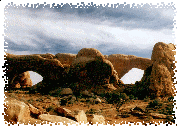 |
| North and South Windows (photo from December 1996) |
The Windows Section is named after the North and South windows, a set of twin arches. Nearby Turret Arch is also a double arch, as is Double Arch (not shown here.) Six arches within one square mile is rather impressive. So what causes these arches? The rangers tell us that
 |
| Turret Arch (photo from December 1996) |
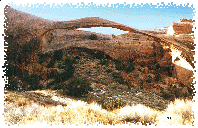 |
| Not Long for this World; Landscape Arch (photo from December 1996) |
Young arches usually start out with very small apertures; the two windows are relatively young, and the skyline arch is getting into middle-age as things go. Over time, the aperture gets larger, and the surrounding stone gets smaller, as in Delicate arch. Some arches collapse catastrophically, others just seem to grow old gracefully, such as Landscape arch, the largest arch in the park (and one of the slenderest: the thinnest part of this 306-foot arch is a modest nine feet thick!)
 |
| Defying Gravity; Balanced Rock (photo from December 1996) |
These sandstone fins don't always erode into arches, either. Hoodoos, as are found in Bryce, occur here too. Balanced rock seems poised to topple off it's base any century now. (It's smaller neighbor already did a few decades back...)
Well, chalk up another park that's definitely on the "must see again" list. So, how many more days until sabbatical?
Tell a Friend about this page!
unless otherwise indicated
All Rights Reserved
Reproduction or distribution without prior written permission is strictly prohibited.
Scripting and DHTML by Technomancer Software
technomancer.ws
Privacy Policy